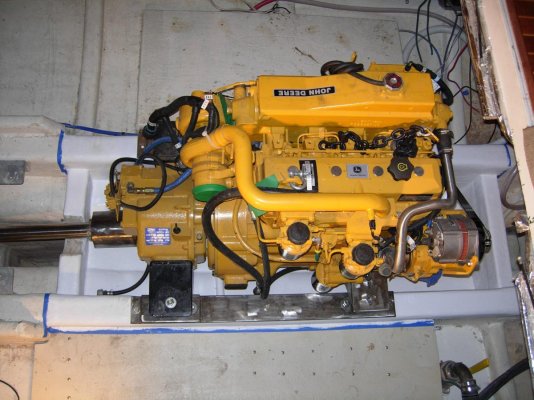Otisguy
Veteran Member
- Joined
- Dec 26, 2010
- Messages
- 88
- Location
- United States of America
- Vessel Name
- Island Spirit
- Vessel Make
- 1976 Hatteras LRC 48'
I am in need of a re power or rebuild of my Detroit 453 Naturals and I know "most people" say just rebuild them old things and they are the most reliable and I read an old thread on here April or 2013 that had some great points for both sides...
I have a 48' Hatteras LRCc that has 453 N Detroits and I have been milking them for the past couple of years.. low compression on most cylinders and smoking for first 10 min after start up but my port motor finally bit the dust and needs a rebuild so I want to rebuild them both.. complete take outs and everything new rebuilds or go with new John Deer 4045T's.. last year I considered it with 4045T's tier 2 (some were still available) that had similar HP of 121 HP to the 453's approx 120 hp in my boat.... the new tier 3's are about 135 hp and my concerns are more HP than needed and longevity.
The Tier 3 at 135 HP are they still a 20,000 hour motors like their non turbo 4045 Naturals Brethren ? Cost is obviously more Repowering with JD but I am leaning toward the new/Cleaner/technology and better fuel consumption and looking at Re Sale down the road...
any opinions especially from anyone that has re powered with John Deers with Turbo's on how happy they are or aren't...
Thanks
OtisGuy
Island Spirit 48' Hatteras LRC 1976 hull #316
I have a 48' Hatteras LRCc that has 453 N Detroits and I have been milking them for the past couple of years.. low compression on most cylinders and smoking for first 10 min after start up but my port motor finally bit the dust and needs a rebuild so I want to rebuild them both.. complete take outs and everything new rebuilds or go with new John Deer 4045T's.. last year I considered it with 4045T's tier 2 (some were still available) that had similar HP of 121 HP to the 453's approx 120 hp in my boat.... the new tier 3's are about 135 hp and my concerns are more HP than needed and longevity.
The Tier 3 at 135 HP are they still a 20,000 hour motors like their non turbo 4045 Naturals Brethren ? Cost is obviously more Repowering with JD but I am leaning toward the new/Cleaner/technology and better fuel consumption and looking at Re Sale down the road...
any opinions especially from anyone that has re powered with John Deers with Turbo's on how happy they are or aren't...
Thanks
OtisGuy
Island Spirit 48' Hatteras LRC 1976 hull #316








